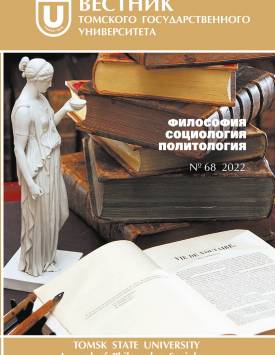Evolutionary mechanisms of scientific progress
The acceleration and progress of science is connected in the article we are discussing by I.T. Kasavin with two factors: internal and external (with the cognitive problematization of available knowledge and the competition of the “institute of normal science and its social alternatives”). Moreover, each of them is interpreted as a condition for creativity and social freedoms. The article substantiates a somewhat similar view on an evolutionary-theoretical foundation. The development and progress of science is understood as one of the manifestations of social evolution, which is carried out in accordance with universal evolutionary mechanisms - (1) variability or variability, (2) environmental selection, (3) consolidation of new properties at some encompassing level. This allows you to look at science from the outside, from the perspective of an external observer who compares the progress in science and neighboring communities (in politics, economy, art, religion, where similar evolutionary mechanisms function). From an internal perspective, it is difficult to choose between vastly different understandings of scientific progress. Today, three main points of view on scientific progress are being debated: a problem-oriented approach in the style of Thomas Kuhn; the semantic understanding of progress as an approximation to the truth (verisimilitude) in the sense of Karl Popper and the epistemic interpretation of scientific development as the accumulation of ever new knowledge. However, none of these understandings conceptualize scientific progress as part of a universal social process, as a natural process of evolution. The mechanism of variability implies the formation of a pool of an excessive variety of scientific proposals (hypotheses, concepts, approaches, descriptions, explanations), which one way or another results in the appropriate communication formats or messages: in the form of preprints, conference abstracts, reports at scientific seminars, grant applications, etc. d. The question of their truth at this stage of the development of science has not yet been fully raised. And of course, only a little of this redundant supply will “get” to the second mechanism for filtering this diversity, namely, to the environmental selection of the most successful scientific messages for their truth or falsity. In science, this mechanism of diversity reduction is represented by the procedures of criticism, review, examination, verification experiments in other laboratories, etc. The author declares no conflicts of interests.
Keywords
system-communicative theory, evolutionary theory, scientific progress, evolutionary mechanismsAuthors
| Name | Organization | |
| Antonovsky Alexander Yu. | Inter-regional non-government organization Russian Society for History and Philosophy of Science | antonovski@iph.ras.ru |
References

Evolutionary mechanisms of scientific progress | Tomsk State University Journal of Philosophy, Sociology and Political Science. 2022. № 68. DOI: 10.17223/1998863X/68/20
